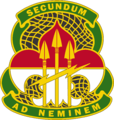United States Army Cyber Command
| U.S. Army Cyber Command | |
|---|---|
 Shoulder sleeve insignia | |
| Active | 2010 –present |
| Country |
|
| Branch |
|
| Type | Advanced persistent threat |
| Role | Cyber operations |
| Part of |
|
| Garrison/HQ | Fort Gordon, Georgia |
| Nickname(s) | ARCYBER |
| Website |
www |
| Commanders | |
| Current commander | Lieutenant General Paul M. Nakasone |
| Insignia | |
| Distinctive unit insignia |
 |
U.S. Army Cyber Command (ARCYBER) is an Army service component command to USSTRATCOM[1] supporting U.S. Cyber Command, for information dominance [2] of cyberspace operations. The command is intended to be the Army's single point of contact for external organizations regarding cyberspace and Information Operations.[3] The single point of contact is accomplished by dual-hatting the single commander for Cyber Command and Second Army.[4] ARCYBER was established on 1 October 2010. Its first commander was Lt. Gen. Rhett A. Hernandez; its second commander was Lt. Gen. Edward C. Cardon.[5] As of 14 October 2016 the current commander is Lt. Gen. Paul M. Nakasone.[6]
Mission
United States Army Cyber Command directs and conducts integrated electronic warfare, information and cyberspace operations as authorized, or directed, to ensure freedom of action in and through cyberspace and the information environment, and to deny the same to our adversaries.
Organization
Army Cyber is the Army service component command supporting U.S. Cyber Command.
Subordinate units, Cyber
- Army Network Enterprise Technology Command
- Army Intelligence and Security Command (INSCOM) will be under the operational control of Army Cyber for cyber-related actions.[7][8]
- 1st Information Operations Command (Land) (1st IO CMD (L))[9]
- 1st Battalion - Trains and deploys field support, vulnerability assessment, and OPSEC awareness teams.
- 2d Battalion - Conducts Army cyber opposing force operations at military training centers worldwide.
- 780th Military Intelligence Brigade (Cyber)
- 1st Information Operations Command (Land) (1st IO CMD (L))[9]
History

The Army achieved an initial cyber operating capability in October 2009 by employing the Army Space and Missile Defense Command/Army Forces Strategic Command (USASMDC/ARSTRAT) supported by NETCOM/9thSC(A), 1st IO CMD (L) and INSCOM. The command was originally announced to be named Army Forces Cyber Command (ARFORCYBER).[7] The command was established on Oct.ober 1, 2010 with the name Army Cyber Command (Army Cyber), commanded by then-Maj. Gen. Rhett A. Hernandez.[10][11][12][13] There are plans for the command to move to Fort Gordon, in Augusta, Georgia home of the United States Army Cyber Center of Excellence, the U.S Army Cyber Corps and Signal Corps.[14]
Past commanders
| Date Began | Date Ended | Commanding General |
|---|---|---|
| October 2010 | September 2013 | LTG Rhett A. Hernandez |
| September 2013 | October 2016 | LTG Edward C. Cardon |
| October 2016 | Present | LTG Paul M. Nakasone |
See also
References
- ↑ The official regulation, General Order (DA GO 2016-11) was signed by the Secretary of the Army and dated 11 July 2016: Army Announces ARCYBER as an ASCC
- ↑ Cybercom Chief Discusses Importance of Cyber Operations
- ↑ U.S. Army (2 Jul 2010). "ARFORCYBER Headquarters Stands Up in National Capital Region". army.mil. Retrieved 27 December 2010.
- ↑ "HQDA General Orders No. 2014-02" (PDF).
- ↑ Army Cyber welcomes new commander accessdate=2016-10-25
- ↑ "Commanding General". Arcyber.army.mil. October 2016. Retrieved 17 October 2016.
- 1 2 US Department of Defense (24 May 2010). "DoD Release No. 420-10 Establishment of Army Forces Cyber Command". defense.gov. Retrieved 24 May 2010.
- ↑ Amber Corrin (9 December 2010). "Army CyberCom faces tough challenges getting started". defensesystems.com. Retrieved 27 December 2010.
- ↑ U.S. Army (9 Dec 2013). "1st Information Operations Command (Land)". inscom.army.mil. Retrieved 9 Jan 2014.
- ↑ US Army (1 October 2010). "Army establishes Army Cyber Command". army.mil. Retrieved 27 December 2010.
- ↑ Belvoir Eagle (7 October 2010). "U.S. Army Cyber Command stands up at Belvoir". belvoireagle.com. Retrieved 27 December 2010.
- ↑ Henry Kenyon (14 October 2010). "Army cyber unit guards computer networks". defensesystems.com. Retrieved 27 December 2010.
- ↑ Army Public Affairs (1 October 2010). "U.S. Army Cyber Command Assumption of Command Announced". defense.gov. Retrieved 28 December 2010.
- ↑ "Army Settles On Augusta For Cyber Forces Headquarters". nextgov.com. 20 December 2013. Retrieved 22 December 2013.
External links
- U.S. Army Cyber News
- U.S. Army Cyber Command
- Army Cyber Command NCOs take hands-on tour at U.S. Army Women's Museum